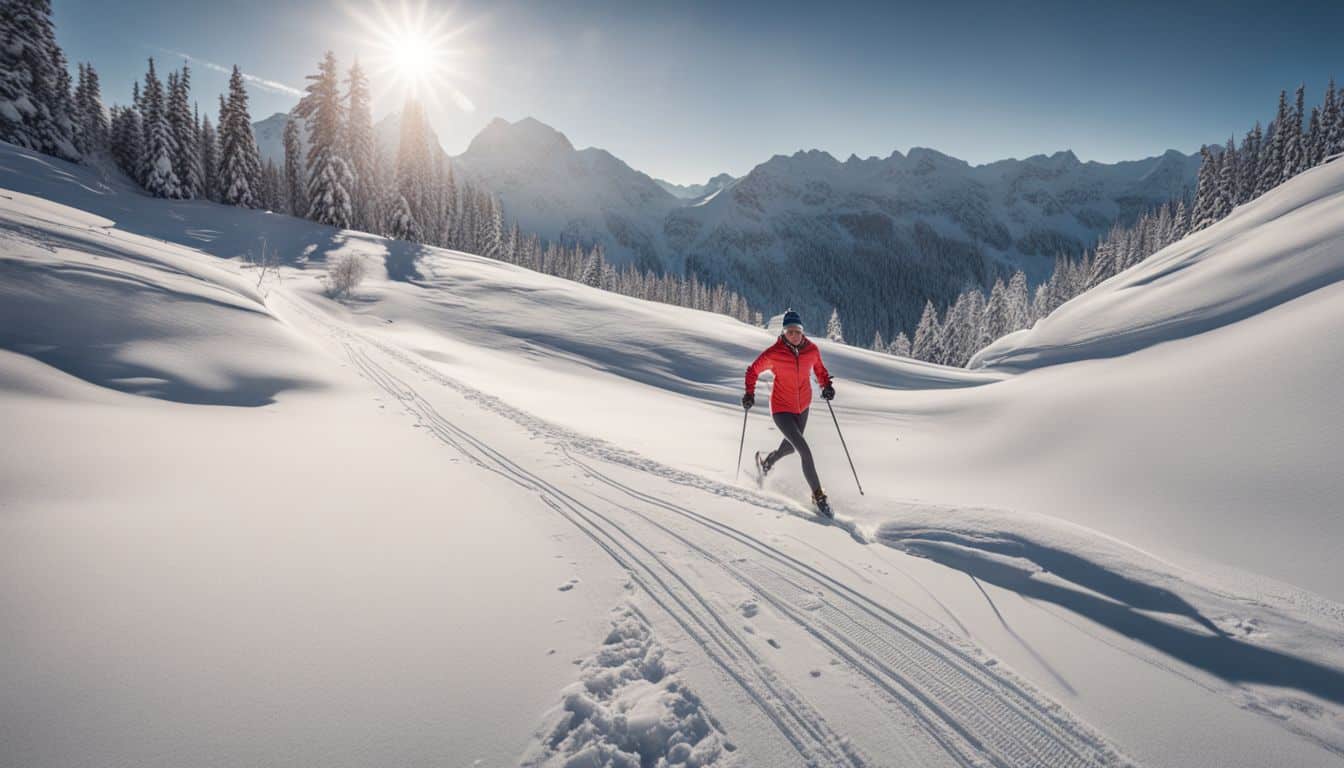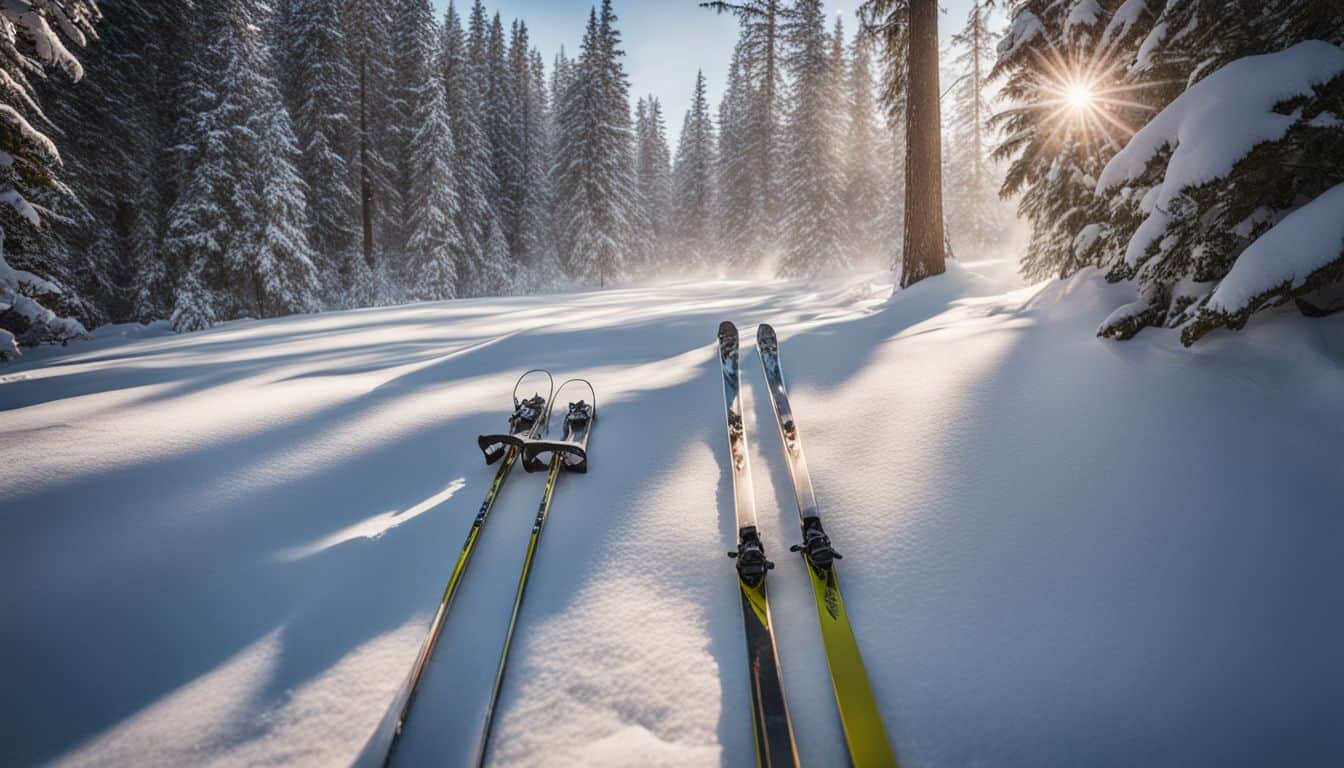Ever feel like holding onto your running fitness feels like a slippery slope during winter’s icy chill? Trust me, I’ve bundled up and faced the biting wind more times than I can count.
In my quest for a solution, I stumbled upon cross-country skiing – an intriguing winter pastime that could just be our saving grace. This blog post is set to serve as your beacon, illuminating how cross-country skiing not only builds strength and enhances endurance but also echoes running fitness without all the high-impact stress.
Ready to trade those frosty jogs for a cool new workout strategy this winter? Let’s explore together!
Key Takeaways
- Cross-country skiing is a great form of cross-training for runners because it mimics running fitness with low impact and helps improve cardiovascular endurance, leg and core strength, balance, and agility.
- It can also enhance breathing and lung capacity while increasing overall VO2 max, which is important for better running performance.
- Compared to other winter cross-training activities like downhill skiing, snowshoeing, and ice skating, cross-country skiing offers similar physical benefits to running with less joint stress.
Benefits of Cross-Country Skiing for Runners
Cross-country skiing is an excellent cross-training activity for runners as it mimics running fitness with low impact, improves cardiovascular endurance, builds leg and core strength, and enhances balance and agility.
Mimics running fitness with low impact
Cross-country skiing is great for runners. It looks like running, but it’s easier on your body. Your feet do not hit the ground hard. So, your knees and joints feel fine after a ski trip.
This makes skiing a good choice for runners who want to train in winter or take care of their joints. Skate skiing is another cool thing to try. The way you move when skate skiing is close to the way you run, which can help you get better at running while also having fun in the snow!
Improves cardiovascular endurance
Cross-country skiing takes your heart health to a new level. Your heart pumps hard during this full-body workout. This boosts your cardiovascular endurance over time. It’s a high-oxygen exercise that makes you breathe deeply and fast.
My own trail running got better from all the cross-country skiing I did in winter. The snow-covered ground slowed me down, but my heart beat faster than ever! Increased oxygen uptake can lead to improved aerobic capacity in runners like us too! With every ski stroke, we train our hearts to be stronger for those long runs ahead.
Builds leg and core strength
Cross-country skiing is a real gym in the snow. It works out my legs and core hard! My quads, hamstrings, glutes are all put to work as I glide across the snow. Not only that, my shoulders get stronger with each pole plant.
But it’s not just about muscle strength. Skiing also tunes up my balance muscles, making me less likely to get hurt when I run trails. Plus, being strong helps me move easier and go longer without tiring out so quickly on runs.
Cross-country skiing sure has proved to be an amazing way for me to build leg and core power while having fun in winter cold!
Enhances balance and agility
Cross-country skiing is an excellent activity for enhancing balance and agility, which are crucial for runners. When you navigate through rough terrains and slide around on the snow, your body constantly tests and improves its agility.
Additionally, Nordic skiing demands more balance and coordination than trail running alone. As a runner, having better balance helps you maintain stability on uneven trails or slippery surfaces.
It also aids in avoiding injuries caused by sudden twists or turns during your runs. So, if you want to improve your balance and agility while having fun in the winter months, cross-country skiing is a great option!
Is Cross-Country Skiing Good Cross Training For Running?

Cross-country skiing is actually a great form of cross-training for runners. It provides similar physical benefits to running, but with less impact on your joints. This means you can build your running fitness without putting as much stress on your body.
Cross-country skiing improves cardiovascular endurance, strengthens leg and core muscles, and enhances balance and agility.
When it comes to increasing VO2 max (which is how efficiently your body uses oxygen during exercise), cross-country skiing can be especially beneficial. In fact, it may lead to greater improvements compared to other types of exercise.
This means that when you go back to running, you’ll have better lung capacity and be able to handle harder breathing and exertion.
So if you’re looking for a challenging yet low-impact way to improve your running performance, give cross-country skiing a try! It’s a fun winter activity that will keep you fit and strong until the snow melts away.
Comparison with Other Forms of Winter Cross Training
Cross-country skiing is a great option for winter cross training compared to downhill skiing, snowshoeing, and ice skating.
Downhill skiing
When it comes to winter cross training for runners, downhill skiing is another popular option. While it may not mimic the running motion as closely as cross-country skiing does, downhill skiing can still provide a great cardiovascular workout.
It engages your leg muscles and core as you navigate down the slopes, helping to build strength and improve balance. Just remember to layer up for warmth, as downhill skiing requires more clothing than cross-country skiing due to the faster speeds and exposure to colder temperatures.
Snowshoeing
Snowshoeing is another great option for winter cross-training if you enjoy running. It’s an easier activity to pick up and learn quickly compared to cross-country skiing, making it accessible for beginners.
Snowshoeing burns a lot of calories – about 740 per hour at a pace of 3.5 miles per hour, which is similar to the calorie burn of running. It’s not only a great workout but also offers opportunities to explore beautiful winter landscapes and enjoy the outdoors.
So, if you’re looking for a fun and engaging way to stay active during the winter months, give snowshoeing a try!
Ice skating
Ice skating is a great winter cross-training activity for runners. It’s similar in motion to skate-style cross-country skiing and can help improve your balance, agility, and lateral hip strength.
Ice skating uses different muscles than running, so it’s a good way to work those balancing muscles that may not get as much attention during your regular runs. While it’s not a substitute for running, ice skating can be a fun and effective way to maintain fitness during the off-season or when conditions don’t allow for outdoor running.
So lace up those skates and give it a try!

How Cross-Country Skiing Translates to Running
Cross-country skiing translates to running by increasing VO2 max, improving breathing and lung capacity, and enhancing muscular endurance.
Increased VO2 max
One important benefit of cross-country skiing for runners is the potential to increase your VO2 max. VO2 max measures how efficiently your body uses oxygen during exercise and is a key indicator of aerobic capacity and endurance.
Research has shown that cross-country skiing can lead to higher VO2 max levels compared to other activities, making it an effective way to improve cardiovascular fitness. Competitive cross-country skiers even achieve some of the highest VO2 max levels among athletes in different sports.
So, by incorporating cross-country skiing into your training routine, you can enhance your breathing and lung capacity, allowing you to sustain higher intensity workouts for longer periods of time.
Improved breathing and lung capacity
Cross-country skiing can have a positive impact on your breathing and lung capacity, which is important for runners. When you engage in cross-country skiing, your body needs more oxygen to keep going.
This helps increase your aerobic fitness and endurance training. By pushing yourself during skiing, you’re training your respiratory system to work harder and take in more air. VO2 max testing has shown that cross-country skiers tend to have higher maximal oxygen uptake compared to athletes in other sports.
Plus, the integrated strength training of exhaling and inhaling while skiing can benefit skiers with asthma as well. So, if you want to improve your breathing and lung capacity for running, give cross-country skiing a try!
Enhanced muscular endurance
Cross-country skiing is an excellent way to enhance muscular endurance for runners. When you cross-country ski, your muscles have to work hard to propel you forward on the snow. This helps to strengthen and condition the muscles in your legs and core, which are crucial for running long distances without getting tired quickly.
Additionally, cross-country skiing can also improve upper body strength because it involves using poles to push yourself along. By incorporating cross-country skiing into your training routine, you can build both upper and lower body strength, leading to enhanced muscular endurance that will benefit your running performance!
Cross-Country Skiing Equipment and Techniques
Choosing the right skis and boots, learning proper skiing techniques, and considering safety precautions are essential for a successful cross-country skiing experience. Read on to find out more about how to make the most of your equipment and improve your technique on the trails.
Choosing the right skis and boots
Selecting the right skis and boots is crucial for a successful cross-country skiing experience. Comfort should be your primary consideration when choosing your equipment. Nordic touring boots are designed to fit a wide range of skiers, making them a great choice for beginners and intermediate skiers.
They are often bigger and feature a 3-pin attachment system similar to classic telemark bindings. On the other hand, classic boots have a narrower performance fit without ankle cuffs and less insulation.
If you want versatility, combi boots can be used for both skate and classic skiing, offering more support. Understanding these options will help you find the perfect fit for your cross-country skiing adventures!
Learning proper skiing techniques
To get the most out of cross-country skiing, it’s important to learn the right techniques. Here are some tips to help you ski efficiently and effectively:
- Get instruction from a skilled instructor: Learning from someone who knows what they’re doing can make a big difference in your skiing skills.
- Focus on proper form: Pay attention to your body positioning and movements while skiing. Maintaining correct form will help you avoid injuries and get the most out of each stride.
- Engage your leg muscles: Cross-country skiing requires strong leg muscles for power and endurance. Make sure to activate your leg muscles as you push off with each stride.
- Use your shoulders: Your upper body plays a role in cross-country skiing too. Engage your shoulder muscles to maximize your power transfer from pole to ski.
- Utilize core strength: Your core muscles provide stability and help with balance while skiing. Keep them engaged throughout your skiing session.
- Start with beginner-friendly tips: If you’re new to cross-country skiing, start with basic tips for beginners. These will give you a solid foundation to build upon as you improve your skills.
Safety considerations
When it comes to cross-country skiing, safety is important. This sport is not without its risks, so it’s crucial to take precautions. Make sure you have the right gear for the conditions and wear protective equipment like helmets and goggles.
Always be aware of the weather conditions and any potential hazards on the trails. It’s also essential to learn proper skiing techniques to minimize the risk of accidents or injuries.
If you’re planning on going into the backcountry, it’s even more important to have specialized equipment and training because this kind of skiing can be hazardous. So remember, stay safe by being prepared and taking necessary precautions while enjoying this winter sport.
Transitioning Back into Running
To safely transition back into running, gradually increase your mileage while cross-training with other activities to maintain overall fitness and prevent injuries or overtraining.
Gradually increasing running mileage
To transition back into running after cross-country skiing, it’s important to gradually increase your running mileage. Start by incorporating short runs into your weekly routine and slowly increase the distance over time.
This approach helps prevent injuries and allows your body to adjust to the demands of running again. For youth athletes or those new to running, easy runs can be added as a second workout when skiing conditions are not optimal.
Remember, taking it slow and steady is key in building endurance and avoiding overtraining. So, start with shorter distances and gradually work your way up as you regain your fitness level.
Cross-training with other activities
During the off-season or when you want to give your body a break from running, it’s important to find other activities that complement and enhance your running performance. Cross-training with other activities can help maintain fitness levels, prevent injuries, and improve overall strength and endurance.
Some great options for cross-training include swimming, cycling, yoga, and strength training exercises. These activities target different muscle groups while still providing a cardiovascular workout.
By engaging in different types of exercise, you can avoid overuse injuries and keep your body balanced and strong. So don’t be afraid to mix it up and try new activities alongside your running routine!
Maintaining fitness during the off-season
During the off-season, it’s important for runners to maintain their fitness levels. This can help minimize the time it takes to regain running fitness when you start training again.
By staying active and engaging in cross-training activities like cross-country skiing or snowshoeing, you can continue to build your cardiovascular endurance and strengthen your muscles.
These activities also provide a low-impact workout that mimics the movements of running without putting too much stress on your joints. So, even though you may not be hitting the pavement as often during the off-season, finding ways to stay active will benefit you once it’s time to transition back into running.
Preventing injuries and overtraining.
Preventing injuries and overtraining is crucial for maintaining a healthy running routine. Cross training can help with this by providing variety in your workouts and giving your body a break from the repetitive impact of running.
This can reduce the risk of overuse injuries like runner’s knee. By incorporating activities like cross-country skiing into your training, you give certain muscles a chance to rest while working others, preventing imbalance and reducing strain on specific areas.
This can also help prevent overtraining syndrome, which is common among endurance athletes like long-distance runners. So, when transitioning back into running after cross-country skiing, remember to gradually increase your mileage and continue to mix in other types of exercise for overall fitness maintenance.
Conclusion on Is Cross-Country Skiing Good Cross Training For Running
Cross-country skiing is a fantastic cross-training activity for runners. It mimics running fitness with low impact and helps improve cardiovascular endurance, leg and core strength, balance, and agility.
Additionally, it can enhance breathing and lung capacity while increasing overall VO2 max. With its similarities to running movement patterns and the added benefits it provides, cross-country skiing is an excellent option for runners looking to diversify their training regimen during the winter months.
So grab those skis and hit the trails for a fun-filled workout that will benefit your running performance!
Can Nike Free Training Shoes Be Used for Cross-Country Skiing?
Nike free training shoes for running are designed specifically for running and may not be suitable for cross-country skiing. Cross-country skiing requires specialized shoes with different features, such as stiffer soles and better insulation. It is important to choose the right equipment for each sport to ensure optimal performance and safety.
FAQs on Is Cross-Country Skiing Good Cross Training For Running
1. Is cross-country skiing a good form of cross training for running?
Yes, cross-country skiing is a great form of cross training for running as it works different muscles and provides a low-impact cardiovascular workout.
2. How does cross-country skiing benefit my running performance?
Cross-country skiing helps improve endurance, leg strength, and overall cardiovascular fitness, which can enhance your running performance.
3. Can I do both cross-country skiing and running in the same week?
Yes, you can incorporate both activities into your weekly routine. Just make sure to plan proper rest days to allow for recovery between workouts.
4. Do I need any special equipment to try cross-country skiing?
To try cross-country skiing, you will need skis, poles, and boots specifically designed for this activity. It’s also important to dress warmly and use appropriate safety gear when necessary.
5. Are there any risks or precautions associated with cross-country skiing as a form of cross training?
While generally safe, it’s important to start gradually and learn proper techniques to avoid injuries while doing cross-country skiing. It may also be beneficial to take lessons from an experienced instructor if you are new to the sport.





Leave a Reply